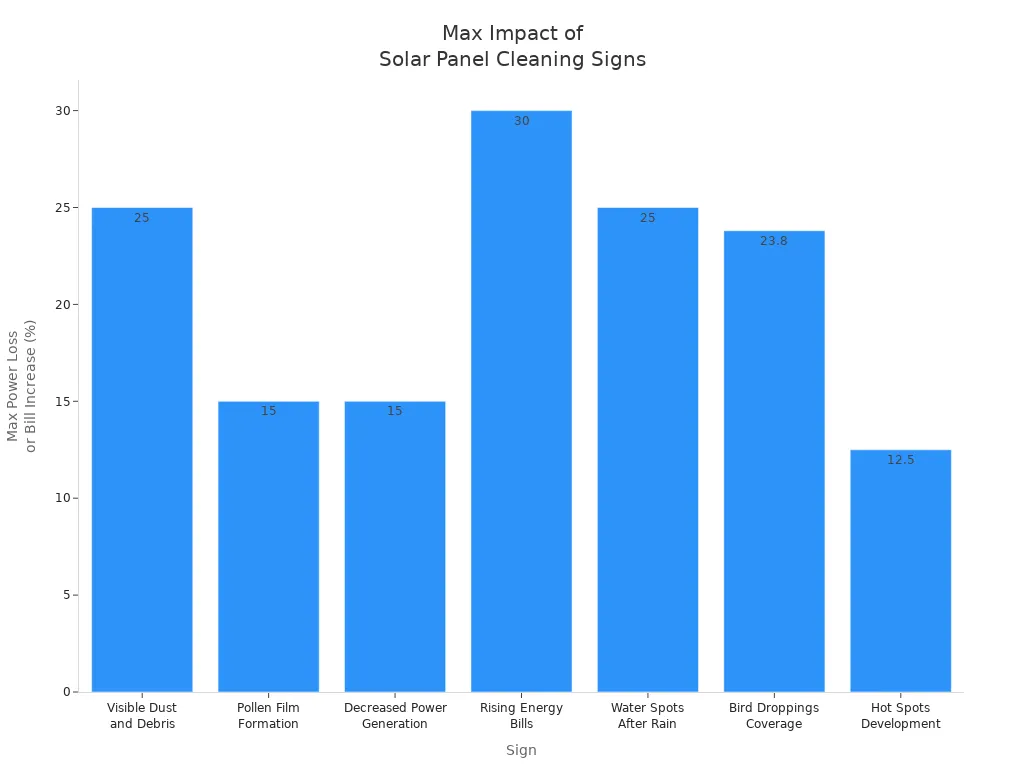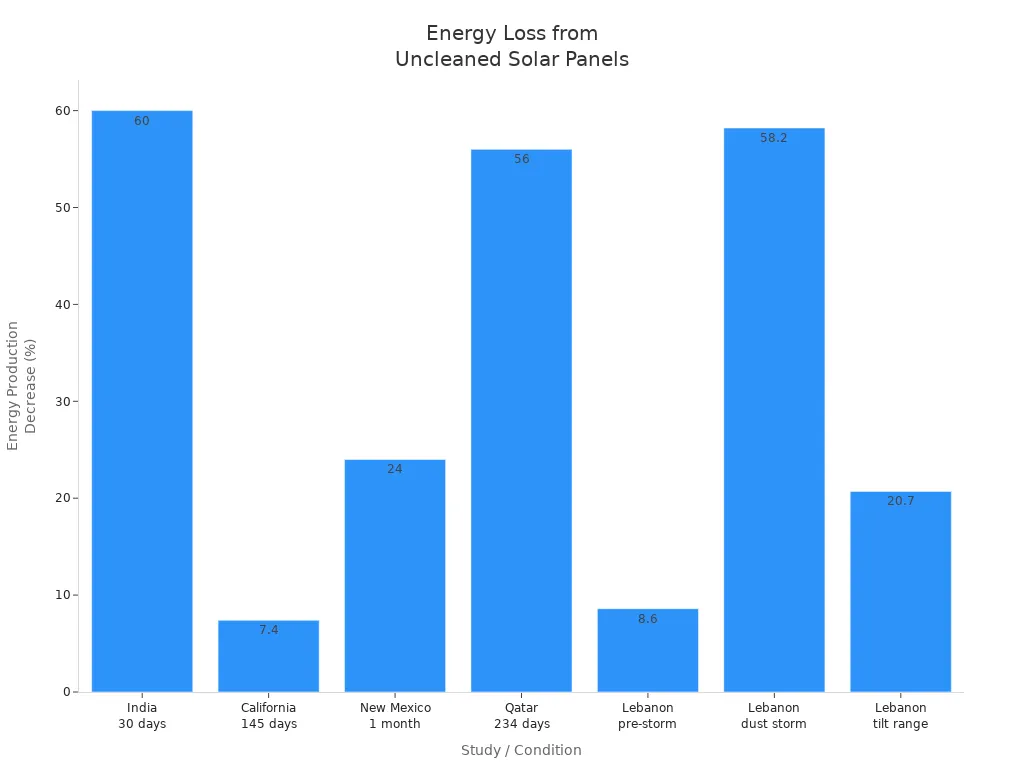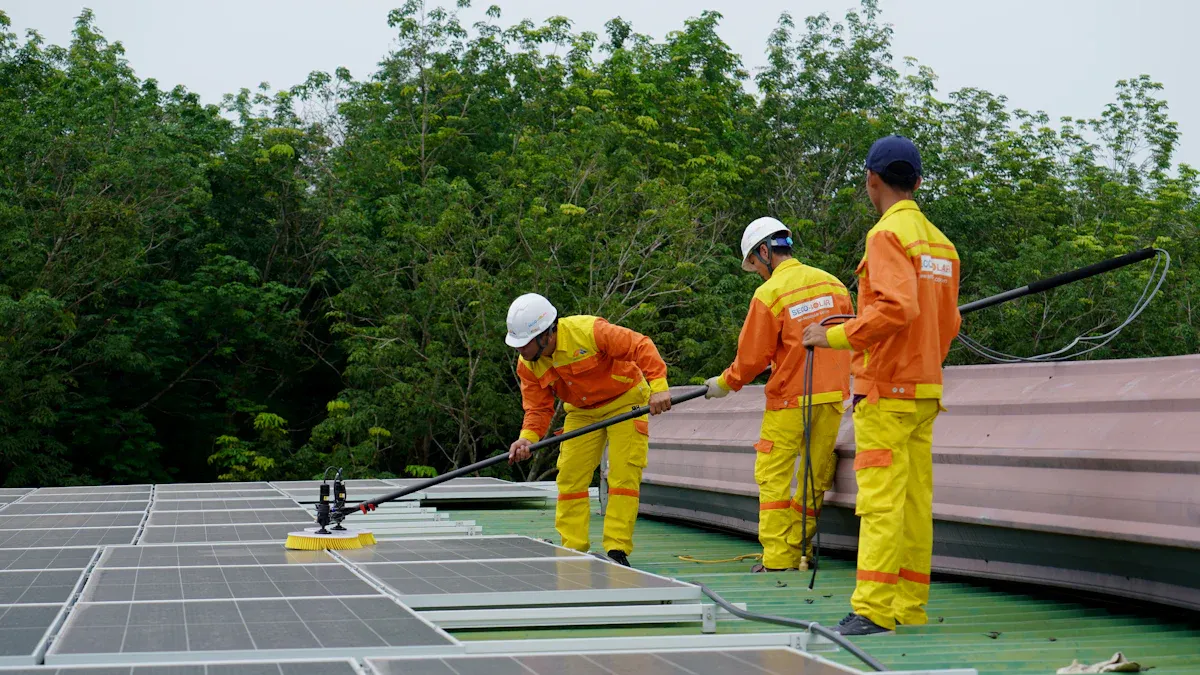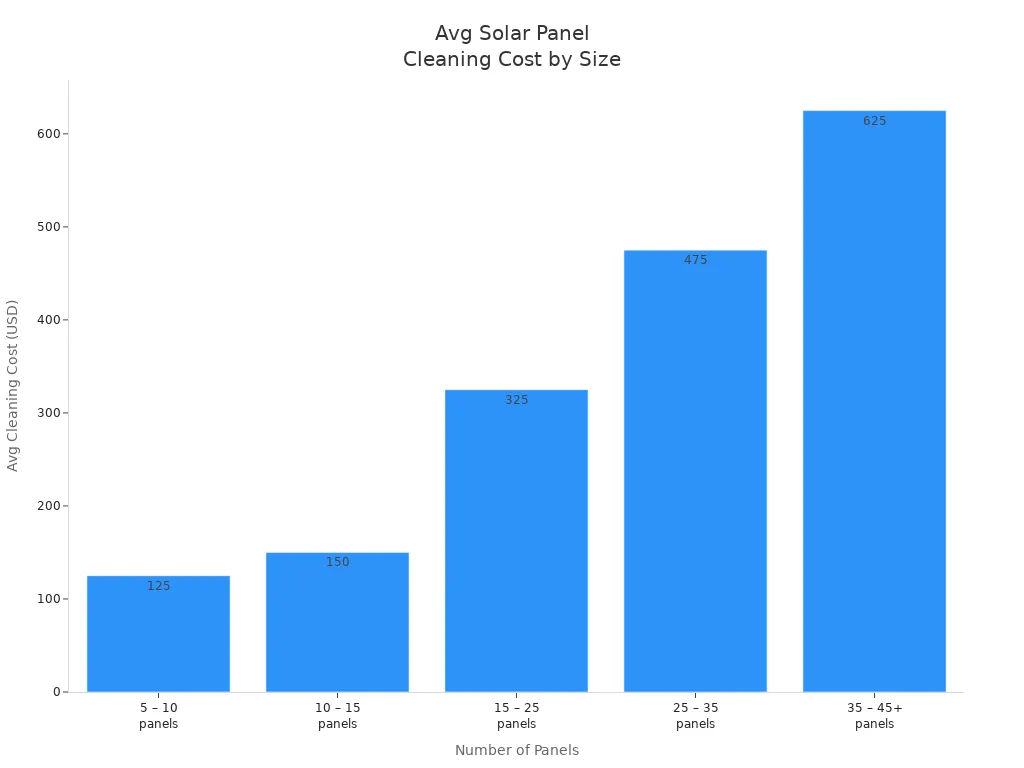Views: 0 Author: Site Editor Publish Time: 2025-07-26 Origin: Site








If you want your solar panels to work their best, you should clean your solar panels at least once or twice a year. Regular solar panel cleaning can boost how much energy you get. Take a look at these numbers from recent studies:
| Cleaning Method | Efficiency Increase (%) |
|---|---|
| Manual cleaning | 5 to 7 |
| Pressurized water | 8 to 12 |
| Robot cleaning | 10 to 15 |
| Automatic self-cleaning | 14 to 20 |

Clean your solar panels once or twice a year. This helps them work well and saves you money on energy.
Check your panels often for dust, bird droppings, or leaves. If you live in dusty, coastal, or polluted places, check more often. Clean more if you see a lot of dirt.
Look for signs like less energy, dirt you can see, or higher energy bills. These signs mean your panels need cleaning.
Use gentle ways to clean, like soft brushes and mild soapy water. Do not use strong chemicals or high-pressure sprays. This keeps your panels safe.
Hire a professional if your panels are hard to reach or very dirty. You can also hire one to keep your warranty and make sure cleaning is safe and works well.
You might wonder, how often should solar panels be cleaned? Most experts and manufacturers say you should clean your solar panels at least once or twice a year. This schedule works well for many homes, especially if your panels get plenty of direct sunlight and you do not live in a dusty or polluted area.
Weekly visual checks help you spot leaves, bird droppings, or other debris before they pile up. Rain can wash away some dirt, but it does not remove sticky stuff like pollen or sap. If your system is older than five years, you should inspect it more often to catch any problems early.
Here’s a quick guide:
| Location/Condition | Cleaning Frequency |
|---|---|
| Typical residential area | 1-2 times per year |
| High dust or pollen areas | Every 3-6 months |
| Coastal regions | Every 2-3 months |
| Near trees/construction | Every 3-6 months |
You do not need to clean your solar panels every week. Over-cleaning wastes time and money. Instead, focus on regular inspections and cleanings based on your local environment.
Where you live makes a big difference in how often to clean solar panels. Dry, dusty places need more frequent cleaning than rainy areas. If you live near a busy road, construction site, or farm, dust and dirt can build up quickly. Urban areas with lots of air pollution also cause more grime to settle on your panels.
Tip: Panels that sit flat collect more dust than those installed at an angle. If your panels are flat, check them more often.
Other things like wind, humidity, and even the angle of your roof affect how much dirt sticks to your panels. For example, dew in the morning can make dust and pollen stick tighter, making it harder for rain to wash them away. In coastal areas, salty air can leave a film that needs to be cleaned off every few months to prevent corrosion.
Seasonal changes matter too. Spring brings pollen, while summer can leave mineral spots after rain. Winter snow can cover panels and block sunlight. After storms or pollen-heavy seasons, it’s smart to check your panels and clean them if needed.
Sometimes, you need to clean your solar panels more than twice a year. If you see dust, leaves, or bird droppings on your panels, it’s time for a wash. A sudden drop in your energy production or a spike in your energy bill can also mean your panels are dirty.
Here are some common signs that you need to clean your solar panels more often:
| Sign | Impact on Performance | How to Detect |
|---|---|---|
| Visible dust and debris | 1-25% power loss | Look at panels from the ground |
| Pollen film | Up to 15% power loss | Yellowish film, especially in spring |
| Water spots after rain | Up to 25% power loss | White spots after rain |
| Bird droppings | 10-24% power loss | White or dark spots |
| Hot spots (uneven heating) | Up to 12.5% power loss | Detected with thermal camera |
| Rising energy bills | 5-30% increase | Compare monthly bills |

If you live near trees or construction, you will probably need to clean your solar panels every three to six months. In coastal areas, salt can build up fast, so a cleaning every two to three months is best. During dry seasons or after dust storms, check your panels more often.
Remember, rain helps but does not do all the work. Sticky pollen, bird droppings, and mineral spots need a proper cleaning. If you notice your solar system is not making as much power as usual, or your bills go up, it’s time to clean your solar panels.
You want your solar panels to make as much electricity as possible. When dust, pollen, or bird droppings cover your panels, they block sunlight and lower your energy output. Field studies show that just two months without cleaning can drop your energy production by about 6.5%. In dry or desert areas, you might lose up to 40% of your power if you skip regular cleaning. That’s a big hit to your savings!
Did you know? Google found that cleaning flat solar panels after 15 months doubled their energy output overnight. Even after eight months, cleaned panels showed a 36% boost in electricity.
Here’s a quick look at how much energy you can lose if you don’t clean your panels:
| Study / Location | Duration without cleaning | Energy Production Decrease (%) | Notes |
|---|---|---|---|
| California, USA | 145 days | 7.4% | Some rainfall present |
| New Mexico, USA | 1 month | 24% | Dry, dusty area |
| Doha, Qatar | 234 days | 56% | Heavy dust buildup |

If you live in a dusty place or have flat panels, you need to pay extra attention. Rain helps, but it does not remove sticky stuff or heavy dirt. Regular solar panel cleaning keeps your system working at its best.
Keeping your panels clean does more than just boost power. It also helps your solar panels last longer. When dirt and debris pile up, they block sunlight and make your panels work harder. Over time, this speeds up wear and tear. If you let debris sit for too long, it can even cause scratches or damage the surface.
Regular cleaning and quick checks help you spot problems early. You can avoid costly repairs and keep your warranty safe.
Neglecting solar panel cleaning can lead to other risks, too:
Pests like birds or rodents may nest under dirty panels and damage wires.
Dry leaves and twigs can build up and increase fire risk.
Dirt buildup can hide cracks or loose connections, which can become safety hazards.
When you clean your panels on a schedule, you protect your investment and make sure your system keeps working for years. Clean panels mean more power, fewer repairs, and a longer lifespan for your solar setup.
You can spot the need to clean your solar panels just by looking at them. If you see dust, dirt, or a layer of pollen, it’s time to take action. In cities, panels often collect dust, smog, soot, and even chemical residues from nearby roads or factories. Bird droppings show up often, too, and they stick much harder than dust. Out in the country, you might notice pollen, sand, leaves, or other natural debris, especially if your panels sit near trees. Dry summers make things worse, piling up dust and dirt on your panels.
| Environment | Common Debris | Extra Notes |
|---|---|---|
| Urban | Dust, smog, soot, chemical residues, bird droppings | More pollution and traffic mean faster buildup |
| Rural | Pollen, sand, leaves, natural debris, bird droppings | More natural debris, especially in spring and fall |
Bird droppings and tree sap do more than just block sunlight. They stick to the surface, cause hot spots, and can even damage the protective coating on your panels. Dust mostly causes shading, but bird droppings and sap can lower your power by up to 24% and may lead to long-term damage. If you see these, don’t wait—clean your solar panels soon.
Tip: Panels tilted at an angle collect more debris than vertical ones. Check them often, especially after storms or pollen season.
Sometimes, you won’t see much dirt, but your solar system just isn’t making as much power as before. A sudden drop in your energy output is a big clue. Most experts say that if you notice a 7% to 10% drop in your system’s efficiency over a few months, it’s time to clean your solar panels. This can happen faster during dry spells or if you live near busy roads or lots of trees.
You can track your system’s performance with a monitoring app or by checking your monthly energy bills. If you see a steady drop, don’t ignore it. Cleaning your panels can restore most of the lost power—sometimes up to 30% if you use the right method.
Look for these signs:
Your energy bills go up, but your usage stays the same.
Your solar app shows lower daily or weekly output.
You notice hot spots or uneven heating on your panels.
If you spot any of these signs, it’s a good idea to clean your solar panels and get your system back to peak performance.
Wondering how to clean solar panels at home? You can do it safely with the right tools and a little planning. Here’s a simple step-by-step guide:
Turn off your solar system before you start.
Check the panels for cracks or loose wires. If you spot damage, call a pro.
Pick a cool, cloudy day or early morning to avoid streaks and burns.
Gather your supplies: a soft brush, hose with gentle spray, bucket of mild soapy water, squeegee, and a soft towel.
Gently sweep off loose dirt and leaves with the brush.
Rinse the panels from top to bottom using the hose. Skip high-pressure sprays.
Use a soft cloth or sponge with soapy water to clean stubborn spots.
Rinse again to remove all soap.
Dry with a squeegee or towel to prevent water spots.
Inspect your work and turn the system back on.
Tip: Use distilled water if you can. It helps prevent mineral spots and keeps your panels looking clear.
Safety comes first when you clean solar panels, especially on the roof. Always use a sturdy ladder and wear non-slip shoes. If your roof is steep, use a safety harness. Never clean panels during rain, high winds, or storms. Turn off your solar system before cleaning to avoid electric shock. Ask a friend to spot you or help hold the ladder. If you feel unsure or the panels are hard to reach, hire a professional.
You might wonder what to clean solar panels with. Skip harsh chemicals like bleach or ammonia. These can damage the panel’s coating and void your warranty. Don’t use abrasive brushes or high-pressure washers. Cleaning panels when they’re hot can cause cracks. Always check your manufacturer’s instructions for approved cleaning solutions. Following these tips is the best way for how to keep solar panels clean and working well.

Image Source: pexels
Sometimes, cleaning your solar panels by yourself just isn’t enough. You might want to call in a professional when you see a lot of dust, pollen, or bird droppings that won’t come off easily. If your panels sit on a steep or high roof, safety becomes a big concern. Professionals have the right tools and know how to clean panels without causing damage.
Here are some reasons to hire a pro for solar panel cleaning:
You live in a dusty, polluted, or coastal area with lots of salt in the air.
Your panels get covered with bird droppings, tree sap, or sticky grime.
You want to keep your warranty valid, since many manufacturers require regular professional cleaning.
You notice a big drop in your energy output, even after it rains.
You feel unsafe climbing on your roof or using ladders.
Note: Professional cleaners follow manufacturer guidelines and use special equipment. This helps prevent scratches, hot spots, and other long-term damage.
DIY cleaning can work for light dirt, but it carries risks. Using the wrong soap or a rough brush can scratch your panels. Professionals make sure your panels stay in top shape and last longer.
You might wonder how much professional solar panel cleaning costs. The price depends on how many panels you have, where they are, and how dirty they get. On average, cleaning a single panel costs between $8 and $25. For a typical home with 15 to 25 panels, you can expect to pay about $150 to $630 per visit.
| Number of Panels | Average Cleaning Cost Range |
|---|---|
| 5 – 10 | $50 – $200 |
| 10 – 15 | $100 – $300 |
| 15 – 25 | $150 – $500 |
| 25 – 35 | $250 – $700 |
| 35 – 45+ | $350 – $900+ |

Most experts suggest scheduling professional cleaning once or twice a year. If you live near farms, deserts, or in a city with lots of pollution, you may need cleaning every three to six months. Rainy areas might need less frequent service. Regular cleaning keeps your panels working well and protects your investment.
If you want the best results from your solar system, clean your solar panels at least once or twice a year. Adjust your schedule if you live in a dusty or coastal area, and keep an eye out for dirt or drops in energy output. Research shows that regular cleaning can restore power generation to almost perfect levels and save you money over time. Proactive care helps you avoid costly repairs and keeps your panels working longer. Stay alert, clean when needed, and call a pro if you need help.
You can check your panels for dust, leaves, or bird droppings. If you see dirt or notice your energy output dropping, it’s time to clean. A quick look every month helps you stay on top of things.
You can use tap water, but distilled water works better. Tap water may leave mineral spots on your panels. If you only have tap water, rinse well and dry the panels with a soft towel to avoid streaks.
Never walk on your solar panels. You could crack the glass or damage the cells. Always clean from the side using a soft brush or hose. If you can’t reach safely, call a professional.
Rain helps wash away some dust, but it won’t remove sticky stuff like pollen or bird droppings. You still need to check your panels and clean them when you see buildup. Rain is helpful, but not enough for a deep clean.